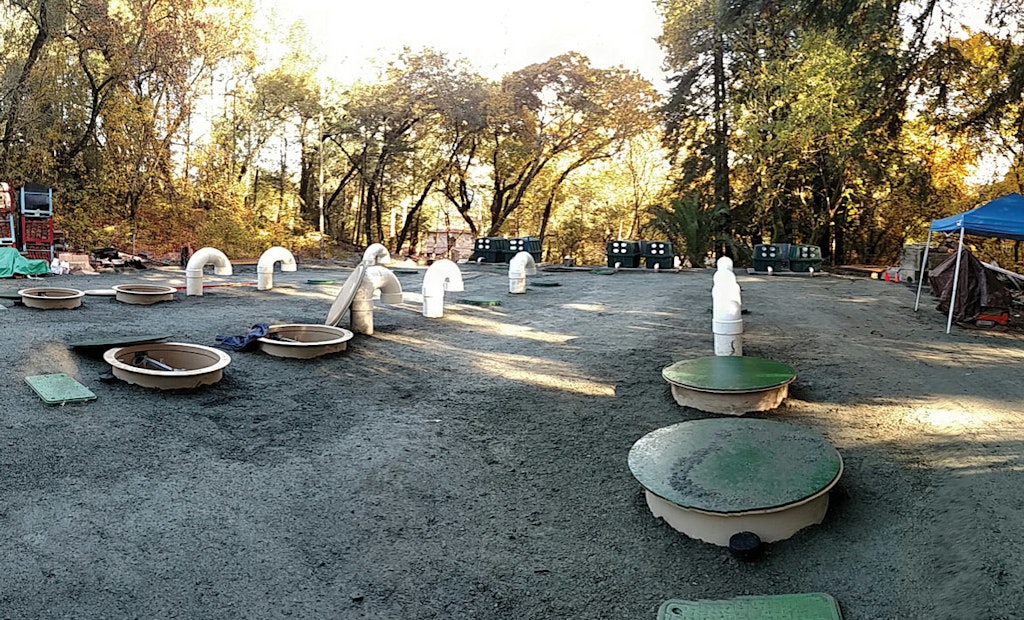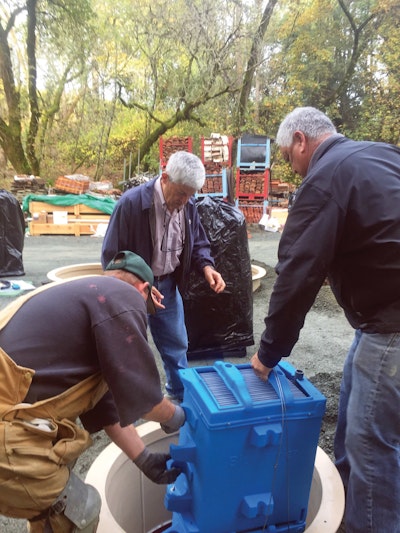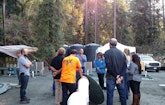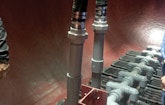
The completed wastewater treatment system for Castello di Amorosa winery shows only the Orenco Systems and Xerxes risers and vents on top of the Xerxes 22,000-gallon tanks. Any of the treatment trains can be shut down for maintenance or when wastewater flows are low. Restarting a train requires moving mixed liquor only a few feet from an operating train. (Photos courtesy Wine to Water Sales Group)
The Castello di Amorosa winery opened in Calistoga, California, in 2007 with a series of large septic tanks and a pressurized distribution system of trenches with rock and pipe to handle its wastewater flows.
“I don’t know how long it really lasted,” Sheldon Sapoznik says. He owns the Wine to Water Sales Group and was called in to help the winery when its original wastewater system failed. “I believe that leachfield lasted only five to seven years.”
The new system, designed by R.E.B. Engineering and installed by Sakai General Engineering, is designed for 9,000 gpd and to handle highly variable wastewater flows with high BOD. It also provides the flexibility of not running every component all the time. Part of the system can be shut down when seasonal flows decrease.
The system
The design retained the old septic tanks for primary treatment and settling solids. From those tanks, water flows to the new system through a 4-inch Schedule 40 PVC pipe. First stop is a concrete distribution box with three 4-inch outlets. Each pipe feeds one of three 3,000 gpd BioMicrobics BioBarrier membrane bioreactor treatment trains that operate in parallel. On each outlet is a valve to control the flow through the pipes, and it is these valves that allow part of the system to be shut down. To restart one of the trains, mixed liquor is piped in from a nearby operational tank.
Before the D-box is a flowmeter to measure the total flow. (There are also flowmeters on the outlet pipes of each bioreactor tank.) And before the D-box is a chemical feed for nitrogen and phosphorus. When grapes are crushed at the beginning of the wine-making process, and during racking when wine is moved from one barrel to another, BOD can reach 12,000 mg/L, Sapoznik says. Despite all the organic matter, nitrogen and phosphorus are significantly lower than is necessary for bacteria to grow and digest waste efficiently, so supplementation is necessary.
Each 4-inch pipe from the D-box enters a Xerxes 22,000-gallon bioreactor tank. There are no baffles inside, but there are two aeration zones covering the first two-thirds of the tank length. Each zone is comprised of 14 molded plastic grids bolted to platforms on the bottom of the tank, and each zone is fed by a 10 hp FPZ regenerative blower. Grids produce coarse bubbles — not the fine bubbles common in package plants — thereby reducing maintenance requirements on the aeration system, Sapoznik says.
Four BioMicrobics BioBarrier double-stack membrane units occupy the other end of the tank. An ITT Goulds Pumps 1/2 hp pump installed in a small vault outside the tank provides suction to draw treated water through the membranes. Each treatment train draws about 6 gpm.
The bioreactor tank size provides the necessary time for microorganisms to digest waste as well as pH buffering, equalization and sludge storage for one year.
“The winery can dump all 9,000 gallons in 20 minutes if they want. The system has the ability, in the volume of that tank, to take that large amount of wastewater in a short period of time without disrupting biological treatment or adversely affecting the function of the treatment system. The system will catch up over the next several hours and return to normal operating levels,” Sapoznik says.
On to irrigation
Beneath each membrane stack is another aeration grid. All four air grids have a single manifold fed by a 4 hp FPZ blower. Grids turn on when the membrane suction pump turns on and provide scouring of the flat sheet membranes, and they also turn on for 30 minutes every two hours to keep membranes clean and add additional oxygen to the treatment process.
“Most wineries do not have dedicated maintenance people on staff to run a typical package plant. So we wanted to build in design parameters to provide enough volume so they can store sludge within the treatment process for at least a year, simplify the process by not having a lot of moving parts, and make operation and maintenance easier,” Sapoznik says.
At startup, the ideal BOD concentration is 500 mg/L. When BOD reaches about 10,000 mg/L, it’s time to pump out some sludge. The suggested pumping removes only 60% to 70% of the mixed liquor in the tank, leaving a sludge concentration for operation. A float maintains about 6 1/2 feet of water in a 10-foot-diameter tank.
After treatment, clean water flows into an underground sump tank of about 1,200 gallons. A duplex pump system sends water into aboveground 50,000-gallon tanks that feed the vineyard irrigation system.
A BioMicrobics panel runs the system. Orenco Systems risers and lids were used for air lines and inlet access, while 36-inch Xerxes risers and 42-inch bolted lids were used above the MBR units.
“With our system, they are surface-irrigating the vineyard with the treated water. This completely removed the need for any belowground dispersal and provided the beneficial reuse desired by the winery,” Sapoznik says.
Challenges
About once a year, maintenance workers perform a clean-in-place of the membranes. During installation, a pipe was installed on each membrane unit for the introduction of a low-chlorine bleach solution for an overnight soak. Every three years, the membranes must be removed and soaked overnight in a bleach or citric acid solution for a deeper cleaning.
Flows through the membranes are measured with the outlet flowmeters and vacuum gauges. When membranes are clean, the vacuum gauge attached to each pump will show minus 6 to minus 10 and flows are about 6 gpm. If the membranes are clogged, vacuum will climb to minus 16 to minus 20 and flows will drop by 50% or more at the same time.
“Those cleaning processes never interrupt the winery’s operation,” Sapoznik says. The vacuum and water flow numbers tell maintenance workers whether the system has enough capacity to handle the high BOD load when grapes are crushed.
“You obviously have to design a system for what the peak flows and loading are, but you don’t want to run a winery system at its peak all the time because a winery operation is so highly varied, and full capacity is overkill for a good portion of the year,” Sapoznik says.
If the winery decides to expand at some time, it would be easy to expand the system to 12,000 gpd by adding another treatment train next to the existing trains. Wineries typically know what their long-term plans are because increased capacity also requires more space for processing and fermentation tanks, he says.
One advantage in working with Castello di Amorosa was the existence of a previous system and wastewater flow data. As a result, many of the design parameters for the new system were known. “A lot of our customers are doing new construction, and we do best-guess estimates based on industry standards and years of experience working with wineries,” Sapoznik says.
Factors such as the total amount of wine produced, how many varieties of each wine will be produced and when grapes are harvested all affect flows through a system.
Handling large BOD loads
Sapoznik spent 20 years as a regulator before going into business for himself. What he saw in those 20 years were systems that people thought could handle high-strength waste or highly variable flows but couldn’t.
An advantage of membrane systems is that they were originally designed for large municipal and commercial uses so they can handle the larger BOD loads common in wineries, he says. Membrane technology also provides some assurance that regardless of flow or BOD, only particles of a certain size will pass through a membrane, which provides better effluent quality and treatment than other technologies, he says.
Most of these systems have effluent BOD of less than 10 mg/L, and the same for TSS. Sometimes the treated water is so clean that a lab cannot detect BOD or TSS, he says.
What it all means for Castello di Amorosa and other wineries — and wine consumers — is years of environmentally friendly production.









